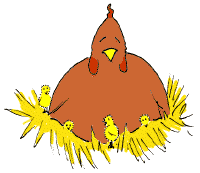
Having recently created an 80 foot by 80 foot organic vegetable patch I suppose I am on the slippery slide into self-sufficientishism. The next obvious step was to produce my own eggs. I kept a dozen chickens about 20 years ago and still had the chicken hut minus its interior fittings as it was being used as a garden shed. It is 6 foot by 8 foot and in excellent condition and just needed the perches and nest boxes reinstating and moving into the orchard out of the garden. Timber was purchased, the new interior fittings made and father-in-law summoned to help with the move.
The chicken hut now relocated was ready to receive its new occupants. We were offered as many chickens as we could catch from a local farm as they were over-run with them but decided to have a fresh start and buy from a reputable breeder.
After much research on the internet we decided to buy 3 different pure breeds so they would lay different coloured eggs. We also decided heavy breeds would be most suitable as they were to be allowed to free range in the goat enclosure with a 5 foot high fence. Light breeds would be able to fly over the fence. We went to purchase our 3 newcomers but only 2 pure breeds were available. 1 Maran and 1 Welsumer, we also bought a Light Sussex cross all point of lay (about 20 weeks old). A few days later we located another breeder who supplied us with a Light Sussex pure breed.
We received conflicting advice regarding suitable
 chicken food and bought a bag of organic layers pellets, wheat and cracked maize. Locally an agricultural merchant was closing down and I managed to purchase suitable feeding and water receptacles. They were also selling special chicken grit for £1 per bag, normally £6. I bought 5 bags and now realise I have enough for the next 500 years!
chicken food and bought a bag of organic layers pellets, wheat and cracked maize. Locally an agricultural merchant was closing down and I managed to purchase suitable feeding and water receptacles. They were also selling special chicken grit for £1 per bag, normally £6. I bought 5 bags and now realise I have enough for the next 500 years!
Chickens must be kept shut in to their new accommodation for a few days so they realise it is home and after they are let out to free range they know where to return. When we finally opened their hatch expecting them to rush out excitedly into the field nothing happened. It was quite a few days before the first one emerged. After a couple of weeks a routine was established. Open their hatch on a morning and they would venture a little further each day and return as and when they liked and at dusk.
We bought our first 3 on 11th February 2004 and on the 12th February we found 1 egg in the newly constructed nest box. By mid-March they were laying 3 eggs regularly and on the 30th March we collected 4.
We mixed the 3 bags of feed but chickens have preferences and sort the different grains consequently scattering a lot on the floor of the shed. Now we only feed organic layers pellets. In June our 4 became 6. We bought one Maran cross and one Black Rock. Again no pure breeds available. To introduce the 2 newcomers we wired a section of the hut off so the existing 4 could carry on as usual and the 2 additions could become accustomed to their new home.
During the summer the Maran and the Welsumer became broody. Not wishing to hatch any new chicks the best thing was to stop the chickens from being broody. This is done by removing them from their cosy surroundings and keeping them in a cage for 2-3 days, sounds cruel but it works. Just provide water and a small amount of food. Another problem is we have had to treat the chickens for lice on a fairly regular basis. We use Barrier a white organic powder.
Although not common where we live, the threat from foxes must be taken seriously and we ensure the birds are locked up safely at dusk. Stoats are more common and we see them regularly. Occasionally the chickens have become very vocal and we have looked across to see a stoat disappearing. I just hope they stick to their regular diet of rabbits.
We have now had the chickens for 8 months and unbelievably they have laid 737 eggs. We used to pay £1.39 for half a dozen organic free-range eggs, which would work out at about £170 worth. All have been enjoyed by ourselves, friends and family. We previously tried to buy the best eggs available but it has to be said there is no comparison. Yorkshire Puddings, Pancakes, Sponge Cakes etc. take on a very yellow appearance when made with our own eggs. Fried, scrambled, boiled, whatever you do with them they are delicious.
The chickens are full of confidence and it is a joy to watch them exploring every inch of their acre of land. It is said pure breeds will not lay as well as crosses which are specially bred to lay eggs. It is also said that Marans do not lay as many eggs but take more care over the ones they do lay. It is also said pure breeds will remain productive for much longer than crosses. We will see as we will allow our birds to live to a ripe old age. It is likely we will have to open a retirement home. If pushed I would have to say the eggs laid by our pure breeds are superior to the ones laid by the crosses. Currently, mid-October the egg laying record for the last 7 days is 3, 4, 5, 4, 3, 4, 3 although it is expected this will fall soon with the diminishing daylight.
One very useful by-product for the organic gardener is the huge amount of chicken poo collected from the droppings board each morning.
Thanks to mike for telling us about his chickens, Harriet from Bath also keeps chickens and the two in the picture at the top belong to her. Also Ajit from India is in the process of building a coup, I thought it looked quite different than any other coup I have seen before and thought that others would like to see it too. So have a look opposite. We love hearing from you so why not visit our forum.



No pictures showed. Would like to of seen the chickens. I have about 50 plus 14 turkeys, all the turkeys are babies yet. :dontknow: